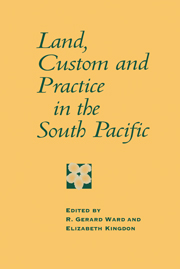Book contents
- Frontmatter
- Contents
- List of Figures
- List of Tables
- Contributors
- Acknowledgements
- Introduction
- 1 Land Use and Tenure: Some Comparisons
- 2 Land Tenure in the Pacific Islands
- 3 Breathing Spaces: Customary Land Tenure in Vanuatu
- 4 From Corporate to Individual Land Tenure in Western Samoa
- 5 Right and Privilege in Tongan Land Tenure
- 6 Land, Law and Custom: Diverging Realities in Fiji
- 7 Beyond the Breathing Space
- Bibliography
- Index
7 - Beyond the Breathing Space
Published online by Cambridge University Press: 10 November 2009
- Frontmatter
- Contents
- List of Figures
- List of Tables
- Contributors
- Acknowledgements
- Introduction
- 1 Land Use and Tenure: Some Comparisons
- 2 Land Tenure in the Pacific Islands
- 3 Breathing Spaces: Customary Land Tenure in Vanuatu
- 4 From Corporate to Individual Land Tenure in Western Samoa
- 5 Right and Privilege in Tongan Land Tenure
- 6 Land, Law and Custom: Diverging Realities in Fiji
- 7 Beyond the Breathing Space
- Bibliography
- Index
Summary
For the past generation, and while they have been endorsing the ideology of development, the leaders of most Pacific Island countries have also emphasised the importance of ‘culture’ and ‘tradition’ as the bases of national identity and the integrity of national institutions. The crucial role of culture is proclaimed in many national constitutions and the need for its maintenance is taken as a basic article of faith by many politicians (Henry, 1991; Somare, 1991), at least in their public utterances. Almost everywhere, native (or customary) land tenure is regarded as one of the cornerstones of national culture, in spite of the fact that what is now proclaimed as traditional may be different from what was customary in the nineteenth and, presumably, earlier centuries.
The case studies presented above show that many current land tenure practices run counter to what is said to be customary in appeals to ‘immemorial’ and unchanging tradition or to the law where land tenure has been codified. The discrepancies arise in part as consequences of growing population pressures, increased participation in wage labour, greater urbanisation, and the demands of cash cropping and commercial grazing. All create changes in the relative demand for and value of different pieces of land according to location and quality attributes related to the needs of new crops or animals or new types of land use. Land tenure practices have changed as a result, although there is often little public or political acknowledgement of the changes. New forms of socio-economic organisation have allowed or required some individuals to opt out of the older communally oriented forms of organisation.
- Type
- Chapter
- Information
- Land, Custom and Practice in the South Pacific , pp. 250 - 264Publisher: Cambridge University PressPrint publication year: 1995
- 2
- Cited by

